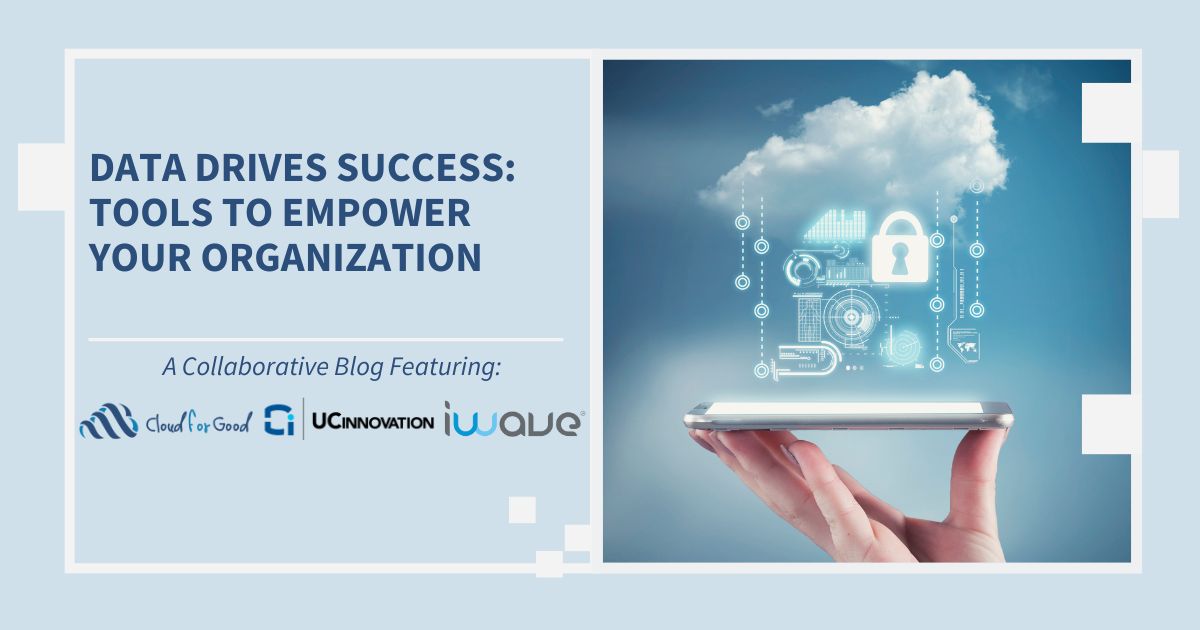Navigating Technology with Salesforce
As Salesforce harbors a thriving ecosystem of partners, such as Cloud for Good, UC Innovation (UCI), and iWave, the technology platform provides an integrated CRM platform that gives all departments across an organization a single, shared view of every constituent. Because Salesforce is flexible as a foundation to build on, it doesn’t force you to change your business processes when the platform is implemented.
Cloud for Good’s role is to help map out these processes, configure Salesforce according to unique requirements, and take the experience gained across over 3,000 implementations to apply best practices to each client. It’s because of that expertise that Cloud for Good is able to recommend, implement, and integrate industry best-in-class solutions, like UCI ascend and iWave, to help support fundraising teams and streamline processes.
Common Fundraising Solutions
The ways in which technology can help you raise more funds are nearly endless. To help simplify the vast selection available to organizations today, let’s break down these solutions into core and supporting systems. Core systems capture the primary elements of constituent engagement that are particularly important to fundraising, such as constituent information systems, data warehouses, business intelligent tools, giving platforms, and constituent relations management (CRM) systems, like Salesforce, just to name a few.
Supporting systems, on the other hand, are just as important as core systems but can be viewed more as point solutions that highlight and capture requirements associated with meeting organizational goals, think event management solutions, constituent portals and directories, and screening tools for prospect management, among many others. Common challenges are experienced in attempting to have all these solutions speak to one another. Sometimes these solutions are difficult to integrate, causing data silos between departments or even within current fundraising structures. This is where Salesforce can come in and take on the majority of both core and supporting system roles to build a truly integrated platform capable of managing data and boosting fundraising efficiencies.
Modern Fundraising Approach
Salesforce Clouds work together to enhance the fundraising approach, leveraging tools like Marketing Cloud to modernize email and mobile marketing, creating intuitive personalization and segmentation through dynamic content and the ability to meet constituents where they’re at. Commerce Cloud can transform the giving process to be in line with other commerce solutions, providing a real shopping cart, and an Amazon-like experience for donors. And the Salesforce CRM platform manages internal processes, centralizing the system for engagement. And you can also take advantage of data for actionable insights.
UCI Innovation’s ascend product sits on top of this platform and provides the functionality needed for modern fundraising. Additionally, Salesforce is designed to interact with other systems and platforms through a robust API; moving data to a data warehouse or from a constituent information system and can pull data in from other tools. This becomes an integral part of the overall technology strategy, providing a full perspective of how constituents are engaging with the organization. AppExchange solutions, such as iWave, can help augment data to maximize each ask from all alumni members.
Becoming a Data-Driven Organization Nonprofit
In today’s digital landscape, data has become a powerful tool for organizations to boost their missions. By embracing a data-driven approach, organizations can unlock valuable insights, build stronger relationships with donors, and optimize their effectiveness.
Implementing these three crucial steps will help you evolve into a data-driven organization.
1. Build a Modern Data Infrastructure
When developing your modern data infrastructure, it’s essential to identify your organization’s specific data needs. Determine how you’ll collect, store, organize, and share information about your constituents. Carefully consider the software, tools, and platforms that align with your organization’s current and future needs.
2. Create a Data-Driven Culture
Developing a data-driven culture begins with setting a clear strategy including measurable goals. Provide your team with resources and training that will enhance their data literacy and encourage them to use data to inform decision-making. Regularly communicate the value of data within your organization.
3. Make Data-informed Decisions
Implementing a modern data infrastructure and creating a data-driven culture will enable your organization to transform outcomes and achieve goals such as fundraising, program objects, and marketing. By leveraging data, you can build more meaningful relationships with donors, acquire new supporters who are likely to contribute and improve efficiency by making data-informed decisions.
Using Data to Cultivate Your Ideal Donors
Now that you’re well on your way to becoming a data-driven organization, let’s discuss the three keys that can inform your fundraising strategies, from building your donor pipeline for major giving or planned giving to maximizing donor retention.
Data plays a crucial role in identifying and cultivating the right donors for your cause. iWave considers the three crucial keys to success as propensity, affinity, and capacity.
Propensity refers to a person’s history of charitable giving, including past donations, frequency, and involvement with other organizations. Analyzing their propensity to give outside of your organization provides valuable insights.
Affinity measures the level of passion a person has for your mission or cause. Understanding their connection to your organization helps gauge their affinity.
Capacity assesses a donor’s wealth and their ability to make significant contributions.
Data-driven organizations have a competitive edge. They can harness the power of data to drive their missions forward, optimize operations, and create meaningful impact. Embracing data-driven strategies can help nonprofits navigate the complex modern world and create a promising future for the communities and organizations they serve!
Data Quality Strategies
Data Quality is critical for a fundraising organization to be successful; a recent statistic shows that bad data in your organization can cause between a 15-25% loss of revenue.
When you are considering your new fundraising system, it is important to review the automation and tools available to manage your data. Today’s systems have built-in automation to support you in your data quality mission. For example, you can leverage system functionality using defined business rules to automate updating and maintaining your data. Relevant use cases include updating a marital relationship when a deceased date is entered on the spouse’s record, or appending “Alumni” to a constituent when a conferred degree is added to the record.
This ability to automate and leverage technology greatly aids the data management team and their efforts to maintain consistent data.
The first step is to create your data definitions and business rules. This will help you develop informed data quality strategies for applying automation to help you in your data management efforts.
Using your business rules – there are many configuration options one can use within Salesforce to manage the dimensions of data quality (Accuracy, Consistency, Completeness, Timeliness, and Uniqueness) that don’t require custom code – they include:
- Required Fields – allow you to configure what fields to make required when creating a record
- Validation Rules – allow you to implement business rules by setting up data validation rules.
- Example: Phone numbers can be no longer than 10 digits
- Flows – allow you to define a business rule that can be triggered before or after a record is saved.
- Example: At least one current address must be flagged as Preferred and the flow updates a preferred flag based on your rules.
Data Integrations
Data acquisitions and Integration require good data management practices. By definition, you are combining your data with another system’s data. And the data from the other system may not be in good condition and can introduce a host of data quality issues via the integration. Examples of potential data quality issues are creating duplicate records or overwriting good timely data with old data that is no longer valid. UC Innovation’s ascend system has two data integration tools that enable bringing high-quality data into the CRM system. The first tool, Interims, is for importing biographic data and the second tool, Review Transactions, is for importing gift information in a.
Interims – Biographic Data
Interims are a staging area for storing biographic information from external sources where the incoming information can be reviewed for accuracy and duplication. It also enables loading data into multiple target objects in ascend from a single data file.
It stores incoming data before it is merged into a constituent or an organization record. This allows the Bio-Demo Specialists and/or System admins to identify possible duplicate records between the “new” data in the interim record and the existing Constituent (Contact) record in ascend/Salesforce.
Records with data that do not adhere to the business rules are held in the interim “staging area” where a user can manually review all the data in the record before merging it into the Constituent (contact).
Interim Benefits include:
- Deduplication – Mass duplication checking
- Data preview
- Manual review/approval flow
- Address cleaning
- Duplicate checking of related data
- Update multiple target objects from a single object load
- Prevents duplicate data from going into the CRM
Review Transactions – Gift Information
Review Transactions is a staging area for importing Gifts, Pledges, and Pledge Payments from external systems in ascend for review before it is automatically processed. This staging area provides the Gift Processing team with the ability to review the gift data for accuracy before it is added to a constituent or organization record in the database.
Review Transactions Benefits include custom processing based on the data interface. Additionally, if the constituent is not found in the database, the system will generate a new interim record to create a new constituent record. The system will also perform data checks; if there is a data issue, the record is automatically set to be reviewed.
With the latest advances in technology, there are many tools and system-supported processes you can use to maintain data quality standards within your organization. By keeping your data quality requirements in mind when reviewing and selecting a new fundraising system, you will be well on your way to implementing a successful data management strategy in your organization.
There are many tools, systems, and processes you can use to maintain data quality and standards within your organization, by following these 5 recommended practices, you will be well on your way to a successful data management strategy in your organization.





